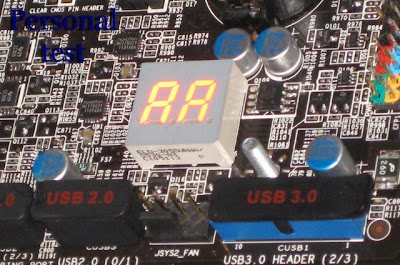| 01 | NMI is disabled and the i286 register test is about to start |
| 02 | i286 register test has passed |
| 03 | ROM BIOS checksum test (32KB from E8000h) passed OK |
| 04 | Passed keyboard controller test with and without mouse |
| 05 | Chipset initialized...DMA and interrupt controller disabled |
| 06 | Video system disabled and the system timer checks OK |
| 07 | 8254 programmable interval timer initialized |
| 08 | Delta counter channel 2 initialization complete |
| 09 | Delta counter channel 1 initialization complete |
| 0A | Delta counter channel 0 initialization complete |
| 0B | Refresh started |
| 0C | System timer started |
| 0D | Refresh check OK |
| 10 | Ready to start 64KB base memory test |
| 11 | Address line test OK |
| 12 | 64KB base memory test OK |
| 15 | ISA BIOS interrupt vectors initialized |
| 17 | Monochrome video mode OK |
| 18 | CGA color mode set OK |
| 19 | Attempting to pass control to video ROM at C0000h |
| 1A | Returned from video ROM |
| 1B | Shadow RAM enabled |
| 1C | Display memory read/write test OK |
| 1D | Alternate display memory read/write test OK |
| 1E | Global equipment byte set for proper |
| 1F | Ready to initialize video system |
| 20 | Finished setting video mode |
| 21 | ROM type 27256 verified |
| 22 | The power-on message is displayed |
| 30 | Ready to start the virtual mode memory test |
| 31 | Virtual memory mode test started |
| 32 | CPU has switched to virtual mode |
| 33 | Testing the memory address lines |
| 34 | Testing the memory address lines |
| 35 | Lower 1MB of RAM found |
| 36 | Memory size computation checks OK |
| 37 | Memory test in progress |
| 38 | Memory below 1MB is initialized |
| 39 | Memory above 1MB is initialized |
| 3A | Memory size is displayed |
| 3B | Ready to test the lower 1MB of RAM |
| 3C | Memory test of lower 1MB OK |
| 3D | Memory test above 1MB OK |
| 3E | Ready to shutdown for real-mode testing |
| 3F | Shutdown Ok - now in real mode |
| 40 | Cache memory now on...Ready to disable gate A 20 |
| 41 | A20 line disabled successfully |
| 42 | i486 internal cache turned on |
| 43 | Ready to start DMA controller test |
| 50 | DMA page register test OK |
| 51 | Starting DMA controller 1 register test |
| 52 | DMA controller 1 test passed, starting DMA controller 2 register test |
| 53 | DMA controller 2 test passed |
| 54 | Ready to test latch on DMA controller 1 and 2 |
| 55 | DMA controller 1 and 2 latch test OK |
| 56 | DMA controller 1 and 2 configured OK |
| 57 | 8259 programmable interrupt controller initialized Ok |
| 70 | Start of keyboard test |
| 71 | Keyboard controller OK |
| 72 | Keyboard test OK...Starting mouse interface test |
| 73 | Keyboard and mouse global initialization OK |
| 74 | Display setup prompt.. Floppy setup ready to start |
| 75 | Floppy controller setup OK |
| 76 | hard disk setup ready to start |
| 77 | Hard disk controller setup OK |
| 79 | Ready to initialize timer data |
| 7A | Timer data area initialized |
| 7B | CMOS battery verified OK |
| 7E | CMOS memory size updated |
| 7F | Enable setup routine if <Delete> is pressed |
| 80 | Send control to adapter ROM at C800h to DE00h |
| 81 | Return from adapter ROM |
| 82 | Printer data initialization is OK |
| 83 | RS-232 data initialization is OK |
| 84 | 80x87 check and test OK |
| 85 | Display any soft error message |
| 86 | Give control to ROM at E0000h |
| A0 | Program the cache SRAM |
| A1 | Check for external cache |
| A2 | initialize EISA adapter card slots |
| A3 | Test extended NMI in EISA system |
| 00 | Call the INT19 boot loader |















